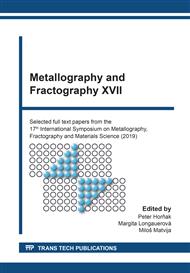[1]
T.B. Massalski, Binary Alloy Phase Diagrams, American Society for Metals, Metals Park Ohio, 1990.
Google Scholar
[2]
S. Cai, T. Lei, N. Li, F. Feng, Effects of Zn on microstructure, mechanical properties and corrosion behavior of Mg-Zn alloys, Mater. Sci. Eng. C 32 (2012) 2570-2577.
DOI: 10.1016/j.msec.2012.07.042
Google Scholar
[3]
Y. Zheng, Magnesium alloys as degradable biomaterials, CRC Press, Boca Raton, n.d. https://www.crcpress.com/Magnesium-Alloys-as-Degradable-Biomaterials/Zheng/p/book/97814665 98041 (accessed March 1, 2018).
DOI: 10.1201/b18932
Google Scholar
[4]
G. Mann, J.R. Griffiths, C.H. Cáceres, Hall-Petch parameters in tension and compression in cast Mg-2Zn alloys, J. Alloys Compd. (2004) 188-191.
DOI: 10.1016/j.jallcom.2003.12.052
Google Scholar
[5]
Q.G. Wang, M. Praud, A. Needleman, K.S. Kim, J.R. Griffiths, C.J. Davidson, C.H. Cáceres, A.A. Benzerga, Size effects in aluminium alloy castings, Acta Mater. 58 (2010) 3006-3013.
DOI: 10.1016/j.actamat.2010.01.032
Google Scholar
[6]
S. Brennan, K. Bermudez, N. Kulkarni, Y. Sohn, Diffusion Couple Investigation of the Mg-Zn System, in: Magnes. Technol. 2012, John Wiley & Sons, Inc., Hoboken, NJ, USA, 2012: pp.323-327.
DOI: 10.1002/9781118359228.ch59
Google Scholar
[7]
C.C. Kammerer, S. Behdad, L. Zhou, F. Betancor, M. Gonzalez, B. Boesl, Y.H. Sohn, Diffusion kinetics, mechanical properties, and crystallographic characterization of intermetallic compounds in the Mg-Zn binary system, Intermetallics 67 (2015) 145-155. doi:10.1016/ j.intermet.2015.08.001.
DOI: 10.1016/j.intermet.2015.08.001
Google Scholar
[8]
T. Zhou, M. Yang, Z. Zhou, J. Hu, Z. Chen, Microstructure and mechanical properties of rapidly solidified/powder metallurgy Mg–6Zn and Mg–6Zn–5Ca at room and elevated temperatures, J. Alloys Compd. 560 (2013) 161-166.
DOI: 10.1016/j.jallcom.2013.01.066
Google Scholar
[9]
Y. Yan, H. Cao, Y. Kang, K. Yu, T. Xiao, J. Luo, Y. Deng, H. Fang, H. Xiong, Y. Dai, Effects of Zn concentration and heat treatment on the microstructure, mechanical properties and corrosion behavior of as-extruded Mg-Zn alloys produced by powder metallurgy, J. Alloys Compd. 693 (2017) 1277-1289.
DOI: 10.1016/j.jallcom.2016.10.017
Google Scholar
[10]
P.J. James, Particle Deformation During Cold Isostatic Pressing of Metal Powders, Powder Metall. 20 (2014) 199-204.
DOI: 10.1179/pom.1977.20.4.199
Google Scholar
[11]
F. Sánchez, A.M. Bolarin, P. Molera, J.E. Mendoza, M. Ocampo, Relationship between particle size and manufacturing processing and sintered characteristics of iron powders., Rev. Latinoam. Metal. y Mater. 23 (2003) 35-40. https://www.researchgate.net/publication/262662762 _Relationship_between_particle_size_and_manufacturing_processing_and_sintered_characteristics_of_iron_powders (accessed March 20, 2019).
Google Scholar
[12]
A. Eksi, S. Saritas, Effects of Powder Hardness and Particle Size on the Densification of Cold Isostatically Pressed Powders, Turkish J. Eng. Environ. Sci. 26 (2002) 377-384.
Google Scholar
[13]
S.K. Das, Y.M. Kim, T.K. Ha, I.H. Jung, Investigation of anisotropic diffusion behavior of Zn in hcp Mg and interdiffusion coefficients of intermediate phases in the Mg-Zn system, Calphad Comput. Coupling Phase Diagrams Thermochem. 42 (2013) 51-58.
DOI: 10.1016/j.calphad.2013.07.002
Google Scholar
[14]
M. Krystýnová, P. Doležal, S. Fintová, M. Březina, J. Zapletal, J. Wasserbauer, Preparation and Characterization of Zinc Materials Prepared by Powder Metallurgy, Metals (Basel) 7, 10 (2017).
DOI: 10.3390/met7100396
Google Scholar
[15]
M. Březina, J. Minda, P. Doležal, M. Krystýnová, S. Fintová, J. Zapletal, J. Wasserbauer, P. Ptáček, Characterization of Powder Metallurgy Processed Pure Magnesium Materials for Biomedical Applications, Metals (Basel) 7 (2017) 461.
DOI: 10.3390/met7110461
Google Scholar


